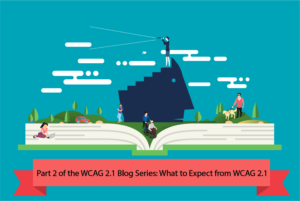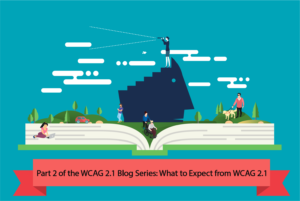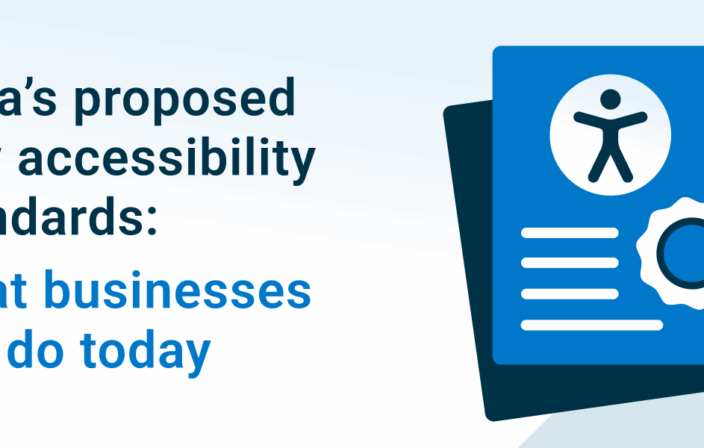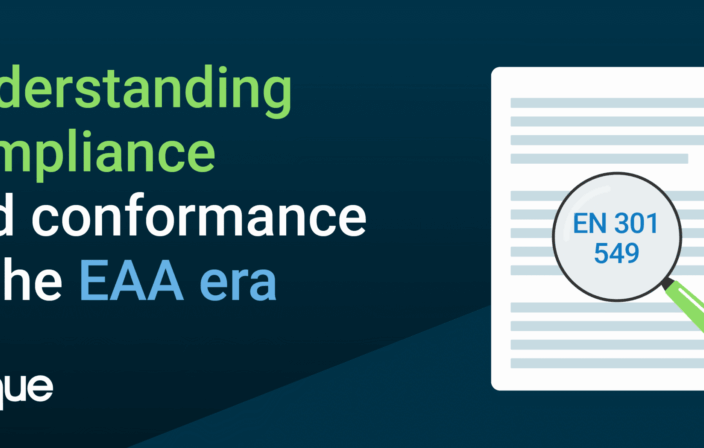
Here we are on a quest to answer the question “What is WCAG 2.1?” My intention is to address this in a few posts. You might find some added context in my first post about the history of WCAG. As a contributor to W3C’s Accessibility Guidelines Working Group, helping to craft the next version of WCAG 2.1. let’s talk more here about what to expect from WCAG 2.1.
If you would like, you can follow along with the recording of this captioned conversation we had in the video below:
What do you think WCAG 2.1 will cover? What’s a high-level overview of what to expect?
The first reminder people need to know is that WCAG 2.1 is an effort to fill known gaps within WCAG 2.0 and that WCAG 2.0 is still fully in play. The known gaps, the major areas of known gaps are in low vision, mobile, and cognitive. Why is this so? Because WCAG 2.0 was published in 2008. If you can even remember what your mobile device looked like back then, you’ll remember a lot of us didn’t have these big-screen devices. A lot of things have changed in mobile, so it makes sense that WCAG didn’t have that covered. Low-vision and cognitive, while they have a little bit in WCAG 2.0, there are some significant barriers that still exist that we need to meet for both of those disability types. Those are the primary areas of focus in WCAG 2.1.
What’s the timeline I can expect for WCAG 2.1 moving forward?
Research for WCAG 2.1 probably goes back even as far as 2008. WCAG is picking up things that didn’t make into WCAG 2.0, so lots of research for a long time and extremely active work has been going on for WCAG 2.1 since January of 2017. WCAG has had a draft release of the guidelines almost every month since January 2017. As fall approaches, the latest draft was published on September 19th, 2017, so that’s the draft that’s out there right now.
WCAG is anticipating two more drafts, around November 15th is likely to be the last working draft because sometime in mid-December to January 2018 there is expected to be a candidate recommendation. A candidate recommendation actually is still a draft, but it’s a much more stable draft. So, Mid-December for a final-final draft. As early as summer of 2018, this WCAG 2.1 standard could become an international standard and recommendation. While people always wonder, “Deadlines, are you meeting ’em?” WCAG will tell you that since January of 2017, WCAG 2.1 has been on time and on schedule. They anticipate this new standard will be finalized and published in summer of 2018.
Knowing this timeline, does it make sense for someone like me to start using WCAG 2.1?
It depends on how you’re coming at it, if you’re trying to apply it in a, “Oh my gosh, I have to meet this legal requirement,” then not quite yet. They would recommend waiting until after the December candidate recommendation gets published because it’s gonna be stable and almost finalized. But the other perspective is, every single one of these items that are even in the September release of the draft are already best practices for accessibility. If you care about accessibility and you’re trying to make accessible websites, you can begin to apply these principles and criteria immediately.
The other thing to keep in mind is if you want to have an impact on what WCAG 2.1 looks like, what it includes and what it doesn’t include, go read it right now, because the acceptance of public comments at some point will close as they start to finalize it. You don’t have a lot more time. Real critical if you want to have an impact on making changes.
Is WCAG 2.1 backward-compatible to the WCAG 2.0?
It absolutely is. There’s no conflict between the two. That was one of the requirements as WCAG wrote it. They really are complementary, so you can go ahead and apply WCAG 2.0, then you would add 2.1 on top of that. They are additional requirements.
Will WCAG 2.1 continue using the A, the double-A and the triple-A standards from 2.0?
Yes, because it’s complementary to WCAG 2.0, it uses that same structure. The A, double-A, triple-A model is still in place. What you’re already familiar with will just have additional success criterion that falls in line at the WCAG 2.1 level.
If I want to contribute to this working draft, what are some requirements for writing good success criteria for WCAG 2.1?
Writing a good success criterion is so hard. To write a good standard that could become an international legal requirement, it must be something that human beings can test reliably. It has to be implementable. It has to be possible to meet the criterion. Each one of these success criteria is technology-agnostic, because of today, while we may talk about HTML and native mobile apps and digital documents, who knows what kind of digital wonders are in our future? The success criterion needs to stay up at a level that is called a condition.
It is important to document the success criterion requirement as a condition, and not loop it in too tightly to HTML or a native mobile language, so that it, too, will stand the test of time. The other thing that should be considered without a doubt is there are three pulls on this. It is, what are the accessibility needs of people with disabilities, and what’s technically possible to do today, and also, what is reasonable? It is critical to look at the cost benefit of doing it. There is a really high bar in writing these, and while it’s very hard work it’s also very intellectually stimulating.
Who is writing this WCAG 2.1?
Some of the best brains in the world are involved in this. What’s super exciting is that the W3C is a completely open and transparent organization. From the get-go, WCAG 2.1 has been written in a way that you could publicly watch it. All the minutes of all the meetings are public. Every draft is public. All comments and questions to each member are public, to the point that WCAG 2.1 is being created out on GitHub, and you can go to that location, read it, and make comments yourself. So, who’s involved in creating this? A number of people who have been involved in creating accessibility in the past, but also, wide-open doors to developers, designers, people with disabilities, lawyers, you name it. Everybody’s welcome.
If I was curious about how this WCAG 2.1 was being made, would I be able to watch that process?
Yes, you definitely can. There is a process in place that the W3C has made very clear lines of how something moves from an idea into a working draft, into a candidate recommendation, into a formal, “This is final.” That process is documented out at the W3C. Everything is published, it is completely open. The only piece that’s not completely open is actual working group meetings if you were to attend. There are twice-weekly phone calls where 80+ people are invited. These meetings are not open, but the minutes from them are open. You can’t attend those without being a current participant of the WCAG working group.
What’s the W3C’s process for publishing these quality technical requirements?
The absolute requirements are, there must be a first public working draft that is available for wide review, early and wide review. It’s not appropriate for WCAG to be creating an international standard and say, “Mm, I’m gonna publish the working draft on Thursday “and they’ll finalize it on Friday.” No way. This thing will have been out there over a year and a half so that people really have that opportunity to give feedback, review it, think on it, see if it’s implementable.
Between the first public working draft and the candidate recommendation, there can be as many public working drafts as needed. There may be none. It is possible to have a first public working draft and go straight to, “We think this is ready for an official vote.” But in this case, WCAG has over five working drafts that have been out there for review before the candidate recommendation. After candidate recommendation, expected to be in mid-December, there will be a formal vote within the membership of the W3C. After the formal vote, there will still be a time period for public comment. Between candidate recommendation and the final, which could be as early as summer of 2018, there can still be changes, but it should be stable enough that those changes are minor.




